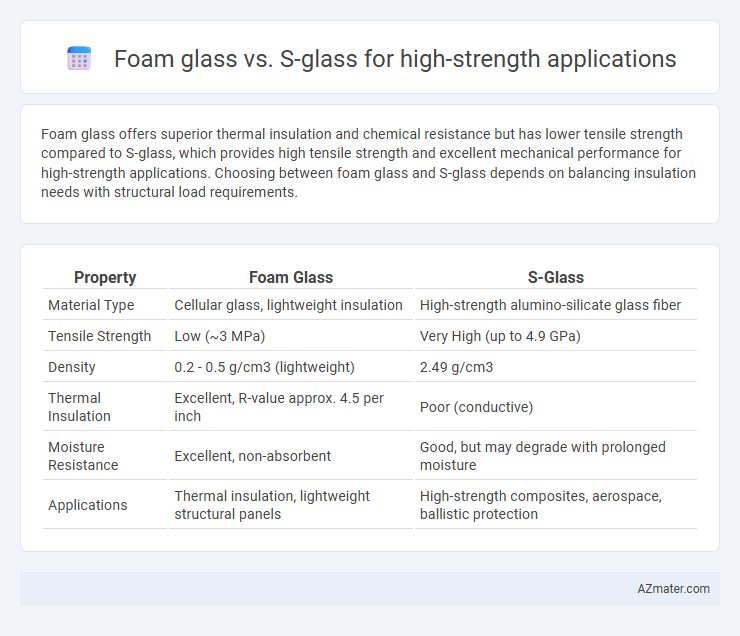Foam glass offers superior thermal insulation and chemical resistance but has lower tensile strength compared to S-glass, which provides high tensile strength and excellent mechanical performance for high-strength applications. Choosing between foam glass and S-glass depends on balancing insulation needs with structural load requirements.
Table of Comparison
| Property | Foam Glass | S-Glass |
|---|---|---|
| Material Type | Cellular glass, lightweight insulation | High-strength alumino-silicate glass fiber |
| Tensile Strength | Low (~3 MPa) | Very High (up to 4.9 GPa) |
| Density | 0.2 - 0.5 g/cm3 (lightweight) | 2.49 g/cm3 |
| Thermal Insulation | Excellent, R-value approx. 4.5 per inch | Poor (conductive) |
| Moisture Resistance | Excellent, non-absorbent | Good, but may degrade with prolonged moisture |
| Applications | Thermal insulation, lightweight structural panels | High-strength composites, aerospace, ballistic protection |
Introduction to High-strength Materials
High-strength materials like foam glass and S-glass serve critical roles in advanced engineering applications due to their exceptional mechanical properties. Foam glass offers lightweight thermal insulation with compressive strength suitable for specific load-bearing uses, while S-glass provides superior tensile strength and impact resistance ideal for aerospace and defense composites. Selecting between foam glass and S-glass depends on balancing factors such as density, strength-to-weight ratio, and environmental resistance for optimized performance in high-strength applications.
Overview of Foam Glass Properties
Foam glass exhibits exceptional compressive strength, lightweight characteristics, and excellent thermal insulation, making it ideal for high-strength applications requiring durability and energy efficiency. Its closed-cell structure provides resistance to moisture, chemical corrosion, and fire, enhancing longevity in harsh environments. Foam glass's versatility in load-bearing capacity and thermal stability distinguishes it from S-glass composites, primarily used for tensile strength rather than insulation or structural insulation purposes.
S-glass: Composition and Characteristics
S-glass is a high-strength fiberglass material composed primarily of alumina (Al2O3) and silica (SiO2), with smaller amounts of magnesia, calcium oxide, and other trace oxides, providing superior tensile strength and modulus compared to standard E-glass. Its enhanced mechanical properties, such as higher fracture toughness, excellent impact resistance, and thermal stability up to 800degC, make S-glass ideal for aerospace and structural reinforcement applications. Unlike foam glass, which is a cellular glass material with excellent insulation but lower mechanical strength, S-glass excels in load-bearing and high-stress environments due to its optimized fiber microstructure and composition.
Comparative Mechanical Strength
Foam glass exhibits moderate compressive strength typically ranging from 3 to 10 MPa, making it suitable for lightweight insulation but less ideal for high-strength structural applications. S-glass fibers, with tensile strengths exceeding 4,900 MPa and high modulus values around 86-90 GPa, deliver superior mechanical performance for demanding applications such as aerospace and ballistic protection. The significant difference in tensile strength and stiffness positions S-glass as the preferred material over foam glass in scenarios requiring high-strength resilience and impact resistance.
Weight and Density Comparison
Foam glass has a density ranging from 0.2 to 0.6 g/cm3, making it significantly lighter than S-glass, which typically has a density around 2.5 g/cm3. The low density of foam glass provides excellent weight savings in high-strength applications but with limited mechanical strength compared to the high tensile strength and stiffness of S-glass fibers. Choosing between these materials depends on the balance between weight reduction and structural performance requirements.
Thermal and Chemical Resistance
Foam glass offers superior thermal insulation and excellent chemical resistance, making it ideal for high-strength applications exposed to extreme temperatures and corrosive environments. In contrast, S-glass provides high tensile strength and good thermal stability but has limited chemical resistance compared to foam glass. For applications demanding both thermal and chemical durability, foam glass is the preferred material due to its inert properties and resistance to acid and alkali attacks.
Durability and Lifespan in Demanding Environments
Foam glass exhibits exceptional durability and a long lifespan in demanding environments due to its resistance to moisture, chemicals, and thermal shock, making it ideal for insulation and structural applications where stability is critical. S-glass, composed of high-strength aluminosilicate fibers, offers superior tensile strength and impact resistance, enhancing durability in aerospace and automotive applications but may be more susceptible to environmental degradation over time without proper coatings. The choice between foam glass and S-glass hinges on specific performance requirements, where foam glass excels in impermeability and longevity, while S-glass provides enhanced mechanical strength under dynamic stress conditions.
Cost-effectiveness and Availability
Foam glass offers excellent insulation and chemical resistance but is generally more expensive and less readily available compared to S-glass, which is widely used in high-strength applications due to its cost-effectiveness and abundant supply. S-glass fibers provide superior tensile strength and durability at a lower price point, making them ideal for composite reinforcement in aerospace and military sectors. The widespread production and established supply chains of S-glass contribute to its competitive advantage over foam glass in cost-sensitive high-performance projects.
Eco-friendliness and Sustainability
Foam glass offers superior eco-friendliness due to its composition from recycled glass and non-toxic materials, providing excellent thermal insulation while being fully recyclable. S-glass, though high-strength and resistant to chemical corrosion, involves energy-intensive manufacturing processes and uses synthetic fibers that pose recycling challenges. Prioritizing sustainability, foam glass stands out as a more environmentally responsible choice for high-strength applications requiring insulation and durability.
Application Suitability: Choosing the Right Material
Foam glass offers excellent thermal insulation and chemical resistance, making it ideal for high-strength applications requiring lightweight, non-combustible materials in construction and cryogenics. S-glass provides superior tensile strength and impact resistance, suited for aerospace, automotive, and sports equipment demanding high structural performance and durability. Selecting between foam glass and S-glass depends on application-specific requirements such as thermal properties, mechanical strength, and environmental exposure.

Infographic: Foam glass vs S-glass for High-strength application
 azmater.com
azmater.com